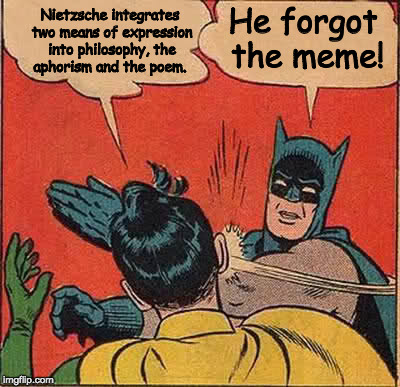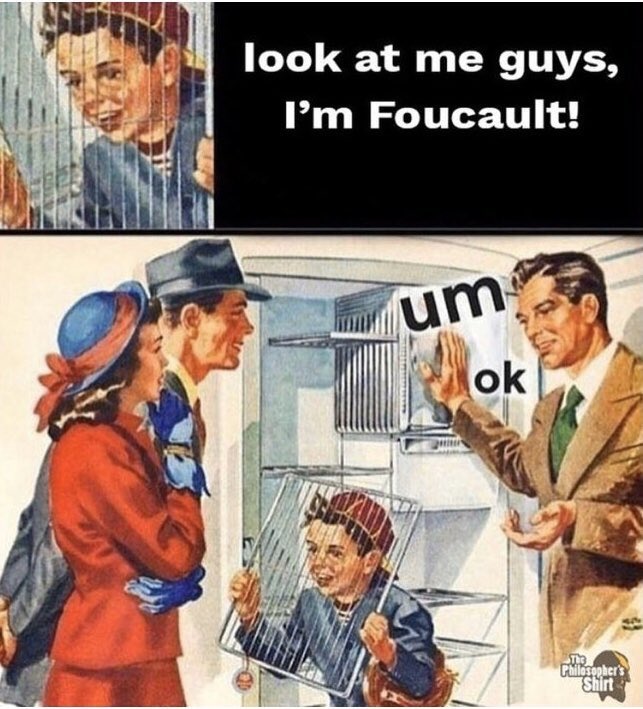I am honored to have been asked to contribute an essay on philosophy through memes for the Wiley-Blackwell Companion to Public Philosophy (eds. Nancy McHugh, Lee McIntyre, and Ian Olasov), currently in preparation.

Writing the piece is a challenge. I don’t know of any literature on the topic and feel like I am having to think things through from first principles. (If you know of anything that might be relevant, do please let me know.)
You might think that because I am in the middle of writing a book, A Certain Gesture: Evnine’s Batman Meme Project and Its Parerga!, that itself does philosophy through memes, I would have a lot of fairly developed thoughts on the topic. And I suppose I do. But my own attempts to philosophize through memes are not all that helpful. First, they are impure. My medium is not the meme, but the meme plus commentary (and the commentaries are parts of an ‘art catalogue’ in which the writing is done by a notionally different person from the creator of the memes). So my resources for doing philosophy are much greater than the exiguous ones of a solitary meme (or even a sequence of memes). At the same time, those extra resources are so specific and idiosyncratic that they offer no basis for generalization. Finally, the image I use has a distinctive feature which is not as a rule found in memes and which is the source of much of the philosophizing I attempt through it: the speech bubbles that derive from its original appearance as part of a comic.

Speech bubbles allow spoken language to be represented by pictures of writing. It is the space between these three – image, writing, speech – that allows me to explore in a practical way the kind of philosophical issues raised by Derrida, in Of Grammatology, and more recently, by Alva Noë in Strange Tools. The difference between writing and a picture of writing, and the different relation each has to speech, became a major theme in the composition of the memes. (It is the topic of a talk I gave recently, available here in Italian and here in English.) Some of the ways in which it shows up in the memes are : footnotes (an exclusively written phenomenon) appearing in the speech bubbles; text represented in different alphabets, including Braille – a primarily tactile rather than visual alphabet); and text and speech bubble appearing in a mirror reflection. Even the use of punctuation in the speech bubbles raises issues since, like footnotes, it is a feature of writing, not speech. (In addition, the exclamation mark, which I came to use so frequently, is a written element that has distinctly pictorial qualities. From top to bottom, a whoosh and a slap!)
None of this, however, has any general application to philosophy through memes. What, then, is philosophy through memes? It is easy to imagine something bland and boring, like this:

A brief quotation from Paley’s version of the Argument from Design is, in very lightly edited form, superimposed onto an image of Paley himself. If this were the best that could be done for philosophy through memes, it would hardly be worth pursuing.
Perhaps we get to something more interesting with this:

The same text now appears over Salvador Dalí’s painting The Persistence of Memory. Putting the text over this surreal depiction of drooping watches now evokes pictorially an obvious objection to Paley’s argument: the ‘watch’ that needs explaining (i.e. the adaptation of means to ends found in the natural world) is not as perfect as all that and therefore hardly suggests the existence of an omnipotent maker. Furthermore, the positioning of the text itself, which echoes the watch on the left, reinforces the imperfection not just of the world, but of Paley’s argument about it.
Perhaps an even better example of philosophy through memes is evident in a meme which, unlike those above, was not made by me. (I don’t know who made it.)

A well-known meme with this image uses the text “The hardest prison to escape is in your own mind.” This Foucauldian sentiment is clearly at work in the present version but whereas the original has the image simply illustrating the idea, here we see the idea being alluded to by the little boy in his play. This emphasizes the super hetero-normativity of the image, thereby connecting the Foucauldian point to the specifics of white, middle-class American life. (I will be showing my students this meme when I teach the chapter of Ellen Feder’s book Family Bonds: Genealogies of Race and Gender in which she discusses the panoptic design of Levittown, a plausible location for the scene in the image.)
Clearly there is a lot more to say about philosophy through memes – but you’ll have to wait until the finished article to learn my thoughts on it. If you have any thoughts of your own, why not leave them in a comment?

Philosophy often gives rise to memes (“The unexamined life is not worth living”;
“Cogito, ergo sum”; “Of that we cannot speak, thereof we must be silent”), but isn’t
there an inherent tension between philosophy and memes? Philosophy, I would
say at least, invites us to reflect thoughtfully on meaning, whereas memes, by
definition, bypass meaning: they just reproduce. So one might argue that when
a piece of philosophy turns into a meme, as in the examples above, it ceases
to be philosophy, at least as far the people who come into contact with its memetic
form are concerned.
LikeLiked by 1 person
I think it’s precisely this reproductive nature of memes what allows philosophy to be expressed through them. Very often you see memes which cannot be understood but by knowing the, shall we say, omnipresence of some other memes. The best memes are, in my view, the ones which figure out how to break the mold/norm in a way, which is not easily reproduced (but still using the same instruments as a merely “reproductive” meme). So basically, how I think a meme does philosophy (which on the most part amounts to reflecting on the medium) is by finding new ways of subverting the mimetic cycle throught mimesis itself. Granted that such subversions will themselves often end up being reproduced, but this also shows the fragility of philosophy, so by philosophising using this very fragile form (because any single instance of a meme is never an “in itself”, otherwise it wouldn’t be a meme), good memes are exposing the fragility of any philosophy, and are thereby doing philosophy.
LikeLiked by 1 person
“subverting the mimetic cycle throught mimesis itself. Granted that such subversions will themselves often end up being reproduced, but this also shows the fragility of philosophy,” I really like this! Thanks so much for sharing these fascinating thoughts!
LikeLike
Hi Manny! Yes, there is of course a tension between philosophy as thoughtful reflection and memes as ephemeral reproductions. The trick will be to find some way to make this tension productive and not destructive, as you suggest it must be! Thanks for these very interesting thoughts!
LikeLiked by 1 person
But why should it be productive? I’m more tempted to go the other way and argue that the challenge for philosophy is to find a way to let its core ideas reproduce *without* turning them into memes. Apparently a contradiction in terms, but there’s your challenge 🙂
LikeLike
Don’t forget about scumbag analytical/continental philosopher. Short simple expositions of arguments and contradictions.
LikeLike
Thank you, yes!
LikeLike